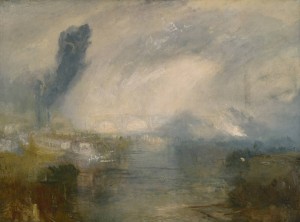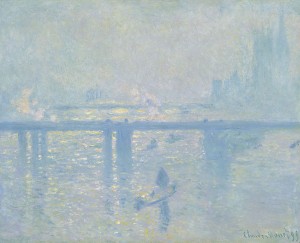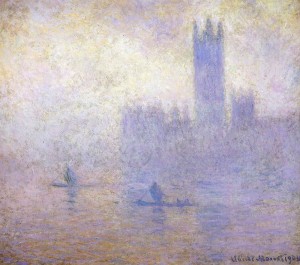Thames Valley bands such as Slowdive, Ride, Chapterhouse and Swervedriver were famously key to London’s shoegaze scene in the early 1990s. But the moody river had already served as inspiration for a the invention of a shoegazy sound a lot earlier. In 1947, after a visit to the English capital, the Polish composer Andrzej Panufnik composed a piece called “Lullaby”, inspired by the night sky over the Thames as seen from Waterloo Bridge. In the piece, two harps play a pulsating, rocking rhythm to represent the flowing waters of the Thames. Above them, 29 solo string players create complex and ultra-delicate harmonic textures by constantly interweaving their chromatically sliding microtonal individual parts. Within this miasma of strings a violin, viola and cello play the lullaby of the title, a simple melodic line based on a Polish folk song. From time to time this line becomes obscured behind the increasingly dense harmonic textures, which reminded Panufnik of clouds moving very slowly across a night sky, sometimes exposing and sometimes covering the outline of the moon.
In its use of quarter tones and dense textures, Panufnik’s piece broke new ground and started a whole trend of string textures in Polish avant-garde music, from Penderecki to Gorecki and beyond. But a sweet melody underpinned by a rocking rhythm and almost drowned by a heavy harmonic haze that sounds like it’s played on a faulty turntable? Sounds to me like the definition of shoegaze.
Around a hundred years earlier, the British painter JMW Turner depicted almost the same spot on the river Thames in a similar shoegazey fashion. In his painting “The Thames Above Waterloo Bridge”, dating from the 1830s, Turner explores the effects of modern industrialisation on his hometown. The painting shows the city’s factories and river traffic producing fumes which all but obscure the bridge. Its gleeful engagement with the commercial capital’s smoke and fog is especially striking when contrasted with a Constable painting of the opening of Waterloo Bridge in 1817, to which it was intended as a kind of response. It’s as if Constable’s clear and detailed patrician panorama is smudged by Turner into a barely penetrable, almost abstract blur of matter and light.
The encounter with the Thames river also signaled a shift towards shoegaziness in the work of the French painter Claude Monet. During his stays in London in 1900-1905, Monet painted a series of paintings of Westminster Palace, home of the British Parliament, which include views of Charing Cross bridge and Waterloo bridge. The paintings all have the same size and viewpoint, the terrace of St Thomas Hospital, overlooking the Thames on the opposite bank, near Westminster Bridge. But they are painted at different times of the day and at different weather circumstances, and are dominated by variations in the light and atmosphere due to the famous London fog, which enveloped the city, especially in autumn and winter.
In order to deal with the great chromatic richness suggested by the city, for this series Manet abandoned his earlier working practice of completing a painting on the spot, as a quick impression. Instead he carried on refining the images back in France, and even sent to London for photographs to help him. The brushstrokes are broken into thousands of coloured patches to render the density of the atmosphere and the mist. The outline of the buildings looms up like an apparition, as the stone architecture seems to lose its substance, dissolving into the sky and water, which are painted in the same tones. We find ourselves immersed in the “envelope” of interactive coloured light which, according to Manet, constantly changes the space between us and what we perceive.
In 1991 My Bloody Valentine were painstakingly laying down the dense layers of their own dissolving envelope of colours and tones. In the run-up to their groundbreaking “Lovesless” album they recorded their own hazy London lullaby, “Moon Song”, taken From the Tremolo EP. The drums mark a hypnotic undulating rhythm, the glide guitars provide the queasy, industrialised microtonal cloud, and the vocal melody appears lovelorn and sweet. Read the lyrics, though, with their depiction of a love-hate relationship fraught with violence, domination and fear, and you realise that these fuzzy lunar landscapes, with all their intimations of sparkly early 20th-century popular music, are very much attuned to the dark side of the moon.
http://www.youtube.com/watch?v=AuvQ14HT3Ok



One Response